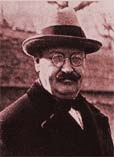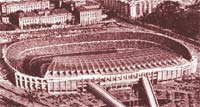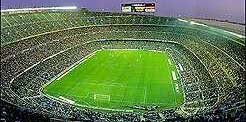shottah's Blog


On the 29th of November 1899, Joan Gamper founded the Football Club Barcelona ( Barça). Gamper chose the famous blue and claret as the team colours for they are the colours of the Swiss canton he came from. The myth was born: Kubala, Suárez, Cruyff, Maradona and Ronaldinho, among many others, have signed up for this Club. During the 20th century, "Barça" has become a Barcelona symbol, a symbol that represents the Catalan identity as a nation. That's why it is said that "Barça" is more than a Club.
THE MYTH IS BORN

In the Solé Gym office, on the 29th of November 1899, Gamper met Gualteri Wild, Lluís d'Ossó, Bartomeu Terrados, Otto Kunzle, Otto Maier, Enric Ducal, Pere Cabot, Carles Pujol, Josep Llobet, John Parsons and William Parsons. Eleven sportsmen gathered in order to found a football club. Gualteri Wild was appointed President. The 1st match contested was at the Bonanova Cycle Track and they played against a group of English expatriates who were living in Barcelona. The Englishmen won 1-0. On the 14th of March 1909, the Club inaugurated its 1st own ground at c/Indústria, with a capacity for 6,000 people. At that time, the Barcelona FC obtained their first victories: The Catalan Championships: 1909-10, 1910-11, 1912-13, 1915-16, 1918-19 1919-20, 1920-21, 1921-22 and the Spanish Championships: 1909-10, 1911-12, 1912-13, 1919-20 and 1921-22.
LES CORTS STADIUM

The Les Corts ground (also known as "The Cathedral of Football") was inaugurated on the 20th of May 1922. That stadium had an initial capacity of 30,000 spectators but later doubled to 60,000. In 1924 the Club had already 12,207 members and a big number of supporters laid the foundations of the current social mass. During the season 1928-1929, Barça won brilliantly the 1st edition of the Spanish National League Title and ended, therefore, a period full of titles.
THE 30'S
Joan Gamper died on the 30th of July 1930. The decade which was about to start had a fatal beginning and the Club entered a period of decline: institutional crisis, many members left the Club, bad sports results and the Franco's supporters political pressure. The Civil War in 1936 had disastrous consequences for the FC Barcelona. Josep Suñol, President of the Club, was murdered by Franco's soldiers near Guadalajara. However, the Barça kept alive and in 1936 decided to go on tour around Mexico and the USA, fact that would help the Club financial problems. In March 1938 the fascists dropped a bomb on the FC Barcelona Social Club and cause serious damage. In 1939, the Franco's troops created many problems to the Club because it had already become a symbol to the Catalan people. The number of members also dropped to 3,486.
LA COPA LATINA (The Latin Cup)
During the 40's, Barça gradually recovered despite their internal difficulties. In June 1943, the scandalous game against Madrid in the Chamartín ground, saw the Barca players threatened by referee and police and Piñeyro, a fascist supporter, but honestly disgusted at the treatment his team had received, resigned from the presidency of the Club (which he had held since 1940). Better times were to come. Barça won the National League Titles 1944-45, 1947-48 and 1948-49 and the Latin Cup Title 1949, a competition which preceded the European Champions Cup Title, the FC Barcelona 1st international success. It was the time of César, Basora, Velasco, Curta, the Gonzalvo brothers, Seguer, Biosca o Ramallets. Barça celebrated their 50th anniversary reaching member numbers of 24,893.
KUBALA
Ladislao Kubala arrived in Barcelona in June 1950 and made the FC Barcelona become an unbeatable team thanks to their magic forward line: Basora, César, Kubala, Moreno and Manchón. Between 1951 and 1953, Barça won every competition on offer (Spanish Leagues 1951-52 and 1952-53 and Spanish Cups 1950-51, 1951-52 and 1952-53). From that golden period, it is important to emphasize the season 1951-52, in which they obtained the Five Cups: Spanish League, Spanish Cup, Latin Cup Eva Duarte and Martini Rossi trophies.
THE CAMP NOU, 1957

Kubala was too huge a figure for Les Corts and soon Francesc Miró-Sans promoted the building of the Camp Nou Stadium, which got inaugurated on the 24th September 1957. The new stadium had a capacity of 90,000.
Barça won the Spanish Leagues 1958-59 and 1959-60, and the Fairs' Cups 1957-1958 and 1959-60, coached by Helenio Herrera with such excellent players as Kocsis, Czibor, Evaristo, Kubala, Eulogio Martínez, Suárez, Villaverde, Olivella, Gensana, Segarra, Gràcia, Vergés and Tejada. The 60's were a period of crisis (they won the Spanish Cups 1963 and 1968 and the Fairs' Cup 1966, only). However, it was then that the sentence "more than a Club" was born. Barça was over the sports level: the Club and its colours became a way to defend the Catalan national identity.
CRUYFF
In 1973, the signing of Dutch Johan Cruyff put the finishing touches to a golden forward line of Rexach, Asensi, Cruyff, Sotil and Marcial, who led the league winning side of 1973-74. Coinciding with the Club's 75th anniversary, there were now 69,566 members, making it the most powerful sporting club in the World. Joan Miró did the commemorative poster of that event
JOSEP LLUÍS NUÑEZ
In 1978, Josep Lluís Núñez became President of the FC Barcelona. The Club then began a considerable period of social and financial expansion. The increase in member numbers reached the 100,000 and many supporter's clubs were founded. The FC Barcelona was becoming the sports most important entity in the world. Barça were also provided with emblematic sports facilities: the Camp Nou expansion (with a capacity of more than 100,000 spectators), the building of the Miniestadi, the Palau Blaugrana, and so on.
The Núñez era constitutes without any doubt the most brilliant sports moment in the Barça history: Basilea Cup Winner’s Cup, the Spanish League 1984-85, under Terry Venables, the Dream Team (1990-1994) under Johan Cruyff (four consecutive Spanish Leagues, the Cup Winners' Cup, the Spanish Cup and the Spanish Super Cup, and the European Champions Cup at the Wembley Stadium). Then came Bobby Robson, who won the Cup Winner's Cup, the Spanish Cup and the Spanish Super Cup in the 1996-97 season and Louis van Gaal's consecutive League Titles in 1997-98 and 1998-99, when the team won the double for the first time in 39 years.
TODAY'S BARÇA
The FC Barcelona is currently a sports entity which includes basketball, handball, hockey, athletism, ice-hockey, figure skating, indoor football, rugby, baseball, volleyball and women's football sections. The football team are the only side to have qualified for European competition every year since its inauguration in 1955. There are now a total of 105,706 members and 1,508 supporters clubs.
Source: www.barcelona.com
This entry has not received any comments yet. You could be the first to leave one.
shottah
21
shottah's Blog Categories
shottah's Friends
Recent Visitors
The last 10 visitor(s) to this Arena were:
shottah's Arena has had 52,328 visits
shottah's Arena has had 52,328 visits


